sensor RENAULT MEGANE 2005 X84 / 2.G Owners Manual
[x] Cancel search | Manufacturer: RENAULT, Model Year: 2005, Model line: MEGANE, Model: RENAULT MEGANE 2005 X84 / 2.GPages: 250, PDF Size: 5.72 MB
Page 36 of 250
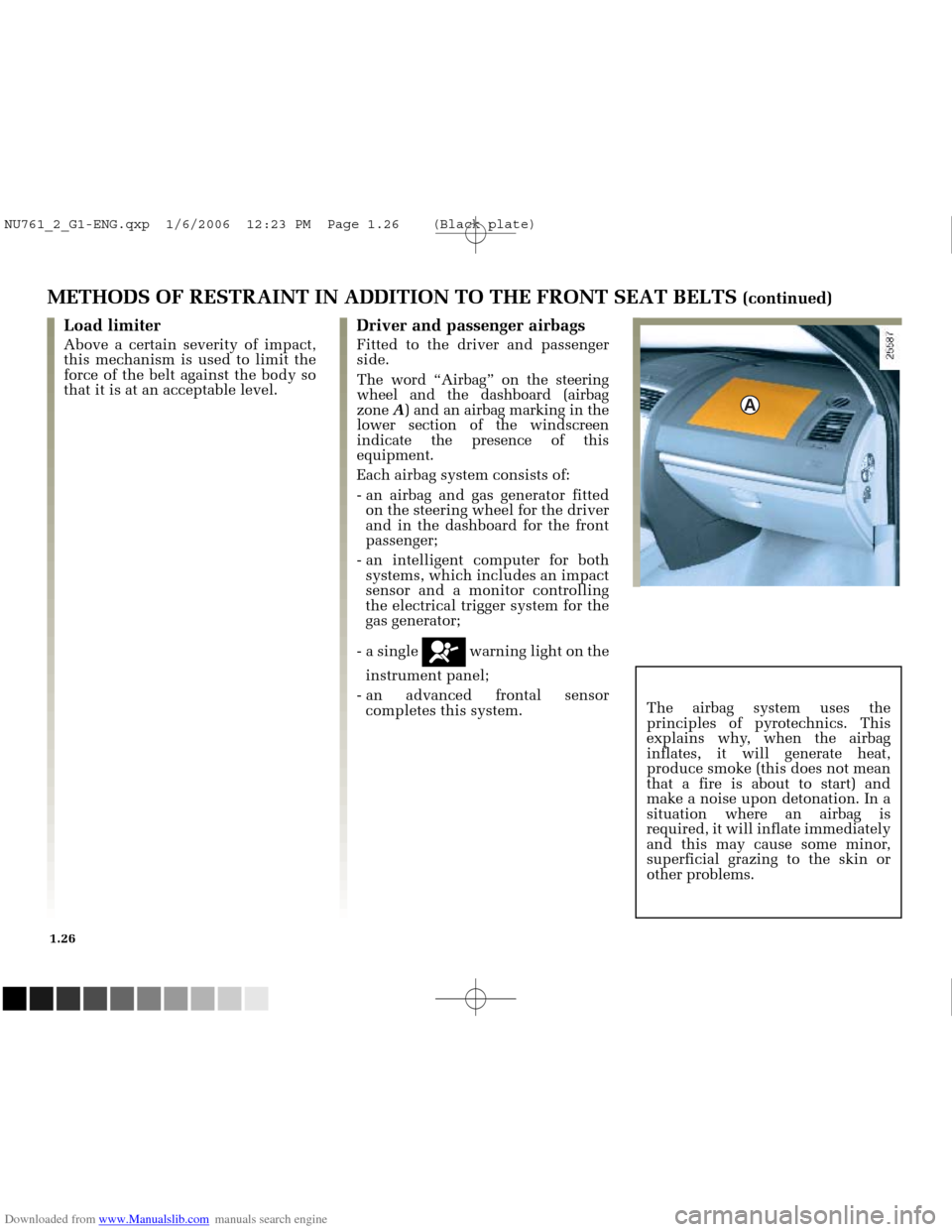
Downloaded from www.Manualslib.com manuals search engine
A
NU761_2_G1-FRA.qxd 10/11/05 15:53 Page 1.26
1.26
METHODS OF RESTRAINT IN ADDITION TO THE FRONT SEAT BELTS (continued)
Load limiter
Above a certain severity of impact,
this mechanism is used to limit the
force of the belt against the body so
that it is at an acceptable level.
Driver and passenger airbags
Fitted to the driver and passenger
side.
The word “Airbag” on the steering
wheel and the dashboard (airbag
zone A) and an airbag marking in the
lower section of the windscreen
indicate the presence of this
equipment.
Each airbag system consists of:
- an airbag and gas generator fitted on the steering wheel for the driver
and in the dashboard for the front
passenger;
- an intelligent computer for both systems, which includes an impact
sensor and a monitor controlling
the electrical trigger system for the
gas generator;
- a single
åwarning light on the
instrument panel;
- an advanced frontal sensor completes this system. The airbag system uses the
principles of pyrotechnics. This
explains why, when the airbag
inflates, it will generate heat,
produce smoke (this does not mean
that a fire is about to start) and
make a noise upon detonation. In a
situation where an airbag is
required, it will inflate immediately
and this may cause some minor,
superficial grazing to the skin or
other problems.
NU761_2_G1-ENG.qxp 1/6/2006 12:23 PM Page 1.26 (Black plate)
Page 84 of 250
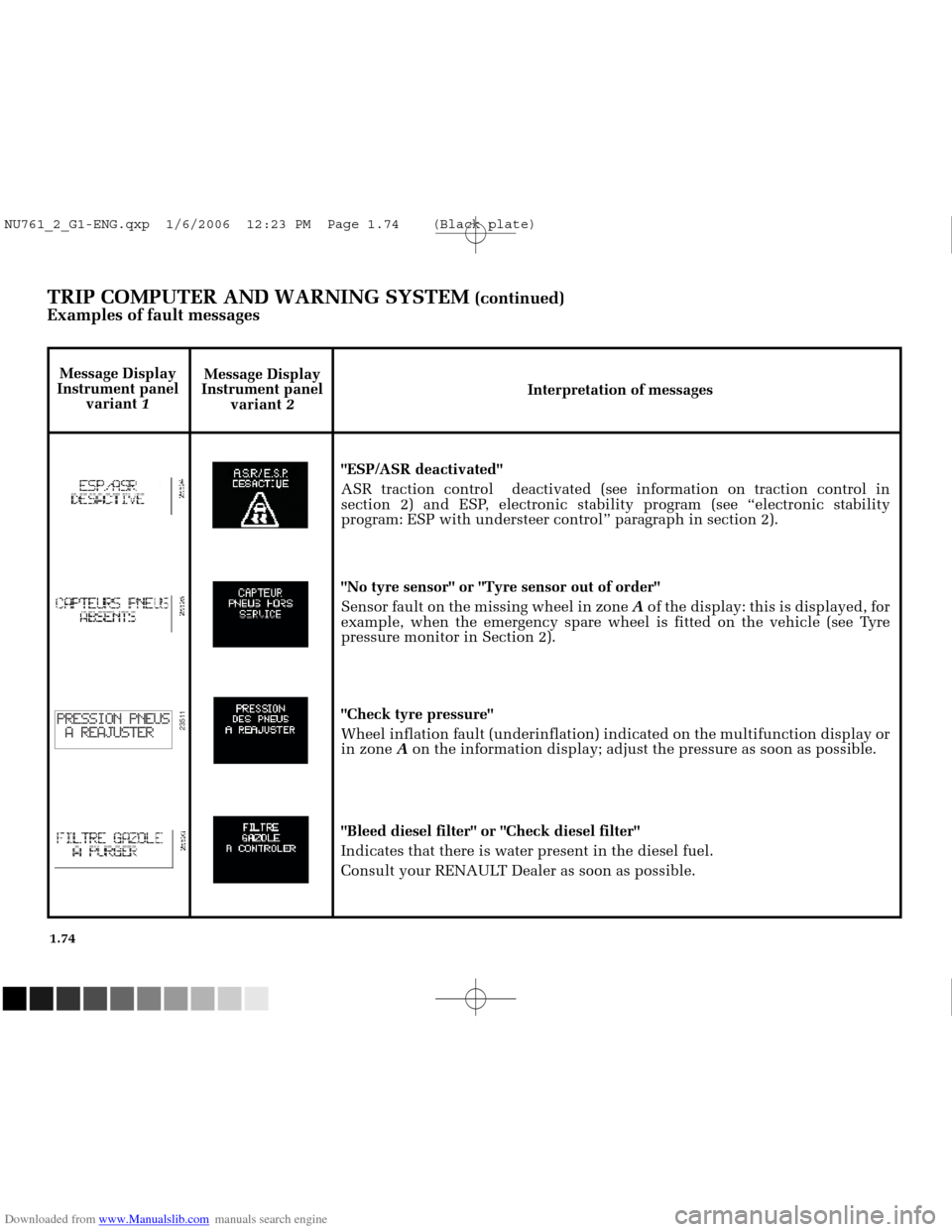
Downloaded from www.Manualslib.com manuals search engine
23511
NU761_2_G1-FRA.qxd 10/11/05 15:54 Page 1.74
1.74
TRIP COMPUTER AND WARNING SYSTEM (continued)
Examples of fault messages
Message Display
Instrument panel variant 2 Interpretation of messages
"ESP/ASR deactivated"
ASR traction control deactivated (see information on traction control \
in
section 2) and ESP, electronic stability program (see “electronic stability
program: ESP with understeer control” paragraph in section 2).
"No tyre sensor" or "Tyre sensor out of order"
Sensor fault on the missing wheel in zone Aof the display: this is displayed, for
example, when the emergency spare wheel is fitted on the vehicle (see T\
yre
pressure monitor in Section 2).
"Check tyre pressure"
Wheel inflation fault (underinflation) indicated on the multifunction \
display or
in zone Aon the information display; adjust the pressure as soon as possible.
"Bleed diesel filter" or "Check diesel filter"
Indicates that there is water present in the diesel fuel.
Consult your RENAULT Dealer as soon as possible.
Message Display
Instrument panel variant 1
NU761_2_G1-ENG.qxp 1/6/2006 12:23 PM Page 1.74 (Black plate)
Page 101 of 250
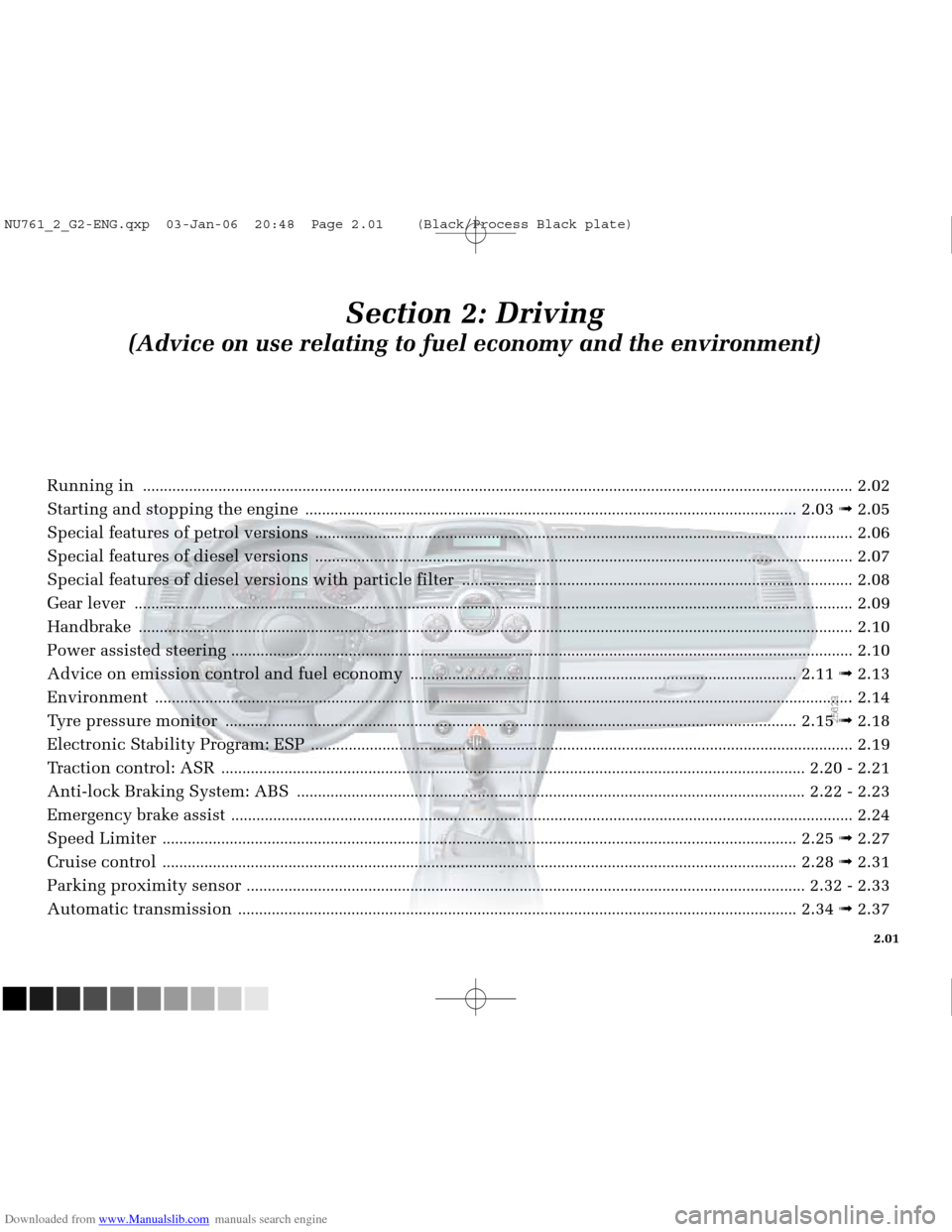
Downloaded from www.Manualslib.com manuals search engine
NU761_2_G2-FRA.qxd 4/11/05 10:48 Page 2.01
2.01
Section 2: Driving
(Advice on use relating to fuel economy and the environment)
Running in ........................................................................\
.................................................................................................2.02
Starting and stopping the engine
........................................................................\
.............................................2.03 ➟2.05
Special features of petrol versions
........................................................................\
....................................................... .2.06
Special features of diesel versions
........................................................................\
....................................................... .2.07
Special features of diesel versions with particle filter
........................................................................\
.....................2.08
Gear lever
........................................................................\
....................................................... ............................................2.09
Handbrake
........................................................................\
....................................................... ...........................................2.10
Power assisted steering
........................................................................\
....................................................... .....................2.10
Advice on emission control and fuel economy
........................................................................\
....................2.11 ➟2.13
Environment
........................................................................\
....................................................... ....................................... 2.14
Tyre pressure monitor
........................................................................\
....................................................... .........2.15 ➟2.18
Electronic Stability Program: ESP
........................................................................\
....................................................... ..2.19
Traction control: ASR
........................................................................\
....................................................... ............2.20 - 2.21
Anti-lock Braking System: ABS
........................................................................\
.................................................2.22 - 2.23
Emergency brake assist
........................................................................\
....................................................... .....................2.24
Speed Limiter
........................................................................\
....................................................... ........................2.25 ➟2.27
Cruise control
........................................................................\
....................................................... ........................2.28 ➟2.31
Parking proximity sensor
........................................................................\
....................................................... ......2.32 - 2.33
Automatic transmission
........................................................................\
....................................................... ......2.34 ➟2.37
NU761_2_G2-ENG.qxp 03-Jan-06 20:48 Page 2.01 (Black/Process Black\
plate)
Page 114 of 250
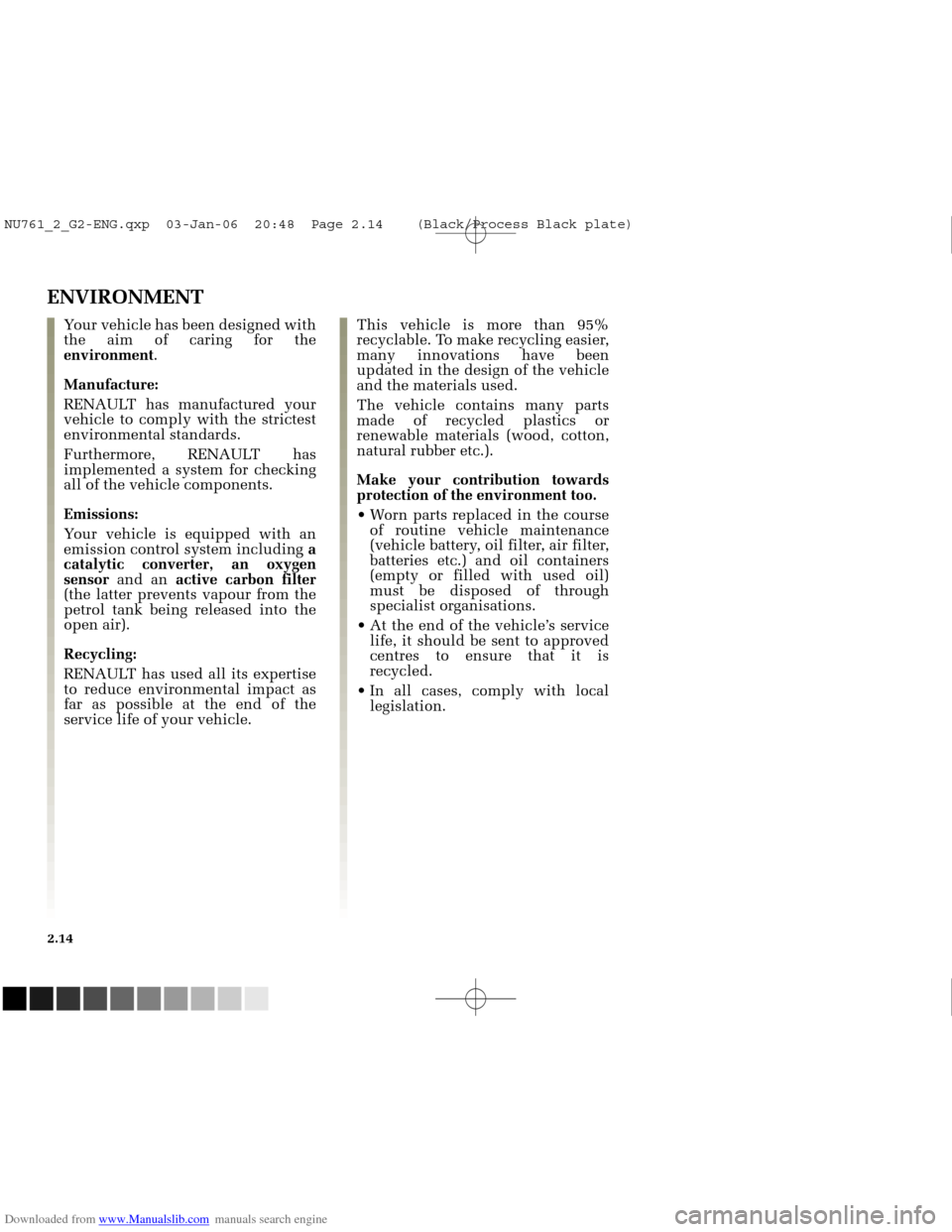
Downloaded from www.Manualslib.com manuals search engine
NU761_2_G2-FRA.qxd 4/11/05 10:48 Page 2.14
2.14
ENVIRONMENT
Your vehicle has been designed with
the aim of caring for the
environment.
Manufacture:
RENAULT has manufactured your
vehicle to comply with the strictest
environmental standards.
Furthermore, RENAULT has
implemented a system for checking
all of the vehicle components.
Emissions:
Your vehicle is equipped with an
emission control system including a
catalytic converter, an oxygen
sensor and an active carbon filter
(the latter prevents vapour from the
petrol tank being released into the
open air).
Recycling:
RENAULT has used all its expertise
to reduce environmental impact as
far as possible at the end of the
service life of your vehicle. This vehicle is more than 95%
recyclable. To make recycling easier,
many innovations have been
updated in the design of the vehicle
and the materials used.
The vehicle contains many parts
made of recycled plastics or
renewable materials (wood, cotton,
natural rubber etc.).
Make your contribution towards
protection of the environment too.
of routine vehicle maintenance
(vehicle battery, oil filter, air filter,
batteries etc.) and oil containers
(empty or filled with used oil)
must be disposed of through
specialist organisations.
life, it should be sent to approved
centres to ensure that it is
recycled.
legislation.
NU761_2_G2-ENG.qxp 03-Jan-06 20:48 Page 2.14 (Black/Process Black\
plate)
Page 115 of 250

Downloaded from www.Manualslib.com manuals search engine
NU761_2_G2-FRA.qxd 4/11/05 10:48 Page 2.15
TYRE PRESSURE MONITOR
Operating principle
Each wheel (except the spare wheel)
has a sensor in the inflation valve
which periodically measures the
tyre pressure.
The system informs the driver that
the tyres are sufficiently inflated
and warns if they are deflated or if
there is a leak.
This system monitors the tyre
inflation pressure.
The pressures must be adjusted
when the tyres are cold.
If tyre pressures cannot be checked
when the tyres are
cold, assume an
increase of 0.2 to 0.3 bar ( 3PSI).
Never deflate a hot tyre.
2.15
This function is an
additional driving aid.
However, the function does
not take the place of the
driver. It cannot, therefore, under
any circumstances replace the
vigilance or the responsibility of
the driver.
Check the tyre pressures, including
the spare wheel, once a month.
NU761_2_G2-ENG.qxp 03-Jan-06 20:48 Page 2.15 (Black/Process Black\
plate)
Page 116 of 250
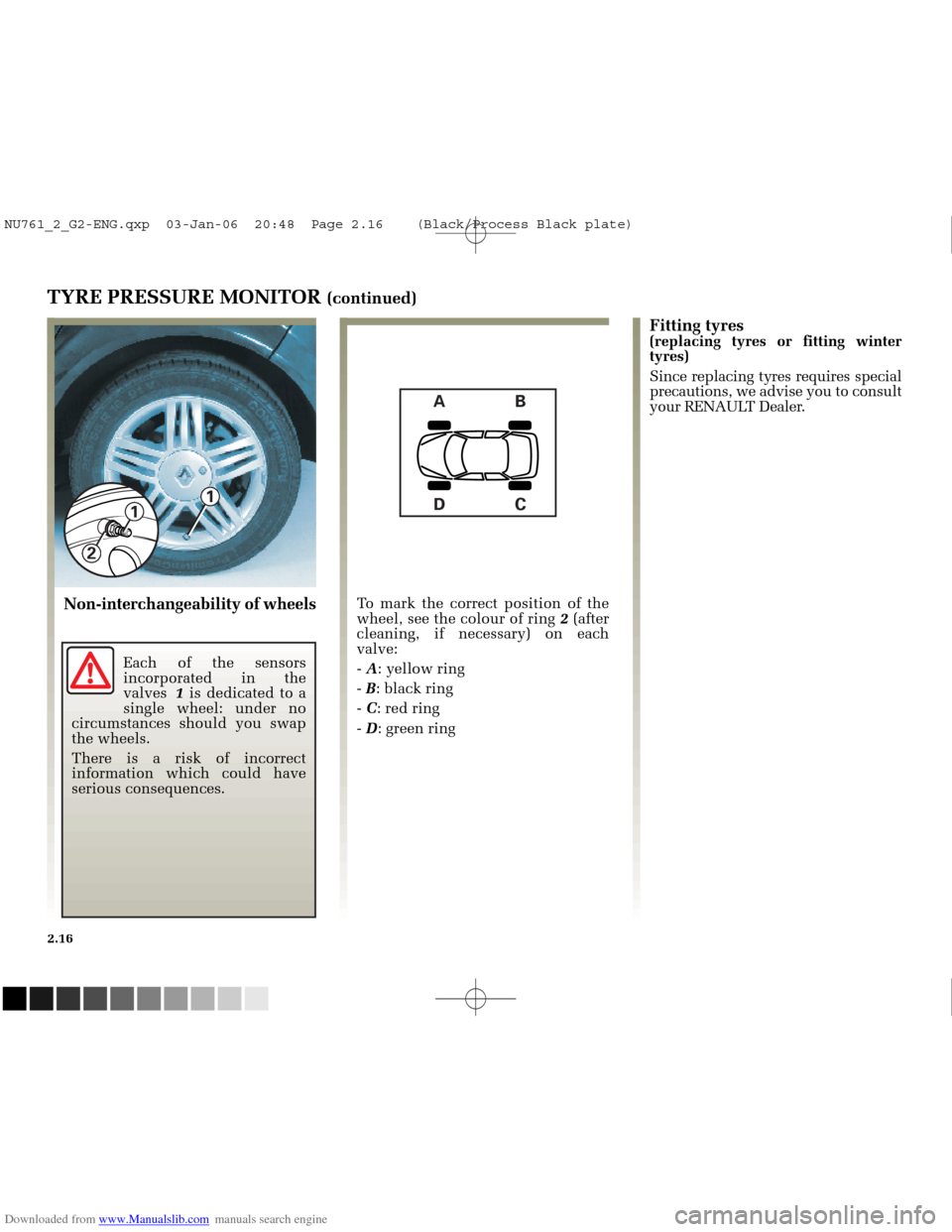
Downloaded from www.Manualslib.com manuals search engine
B
A
C
D
2
1
1
NU761_2_G2-FRA.qxd 4/11/05 10:48 Page 2.16
2.16
TYRE PRESSURE MONITOR (continued)
Non-interchangeability of wheels
To mark the correct position of the
wheel, see the colour of ring 2(after
cleaning, if necessary) on each
valve:
- A : yellow ring
- B : black ring
- C : red ring
- D : green ring
Fitting tyres(replacing tyres or fitting winter
tyres)
Since replacing tyres requires special
precautions, we advise you to consult
your RENAULT Dealer.
Each of the sensors
incorporated in the
valves 1is dedicated to a
single wheel: under no
circumstances should you swap
the wheels.
There is a risk of incorrect
information which could have
serious consequences.
NU761_2_G2-ENG.qxp 03-Jan-06 20:48 Page 2.16 (Black/Process Black\
plate)
Page 117 of 250
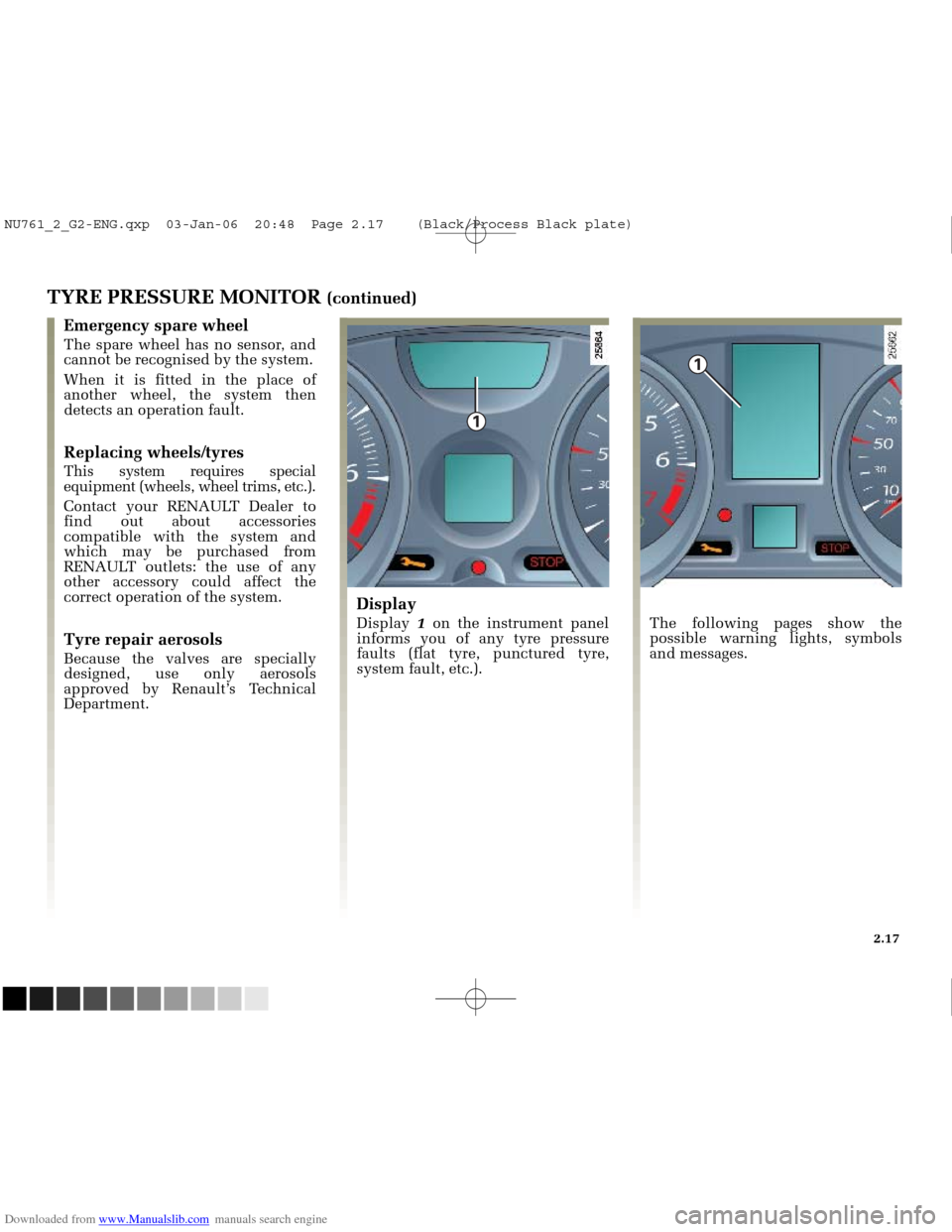
Downloaded from www.Manualslib.com manuals search engine
1
1
NU761_2_G2-FRA.qxd 4/11/05 10:48 Page 2.17
TYRE PRESSURE MONITOR (continued)
Emergency spare wheel
The spare wheel has no sensor, and
cannot be recognised by the system.
When it is fitted in the place of
another wheel, the system then
detects an operation fault.
Replacing wheels/tyres
This system requires special
equipment (wheels, wheel trims, etc.).
Contact your RENAULT Dealer to
find out about accessories
compatible with the system and
which may be purchased from
RENAULT outlets: the use of any
other accessory could affect the
correct operation of the system.
Tyre repair aerosols
Because the valves are specially
designed, use only aerosols
approved by Renault’s Technical
Department.
Display
Display 1on the instrument panel
informs you of any tyre pressure
faults (flat tyre, punctured tyre,
system fault, etc.). The following pages show the
possible warning lights, symbols
and messages.
2.17
NU761_2_G2-ENG.qxp 03-Jan-06 20:48 Page 2.17 (Black/Process Black\
plate)
Page 118 of 250
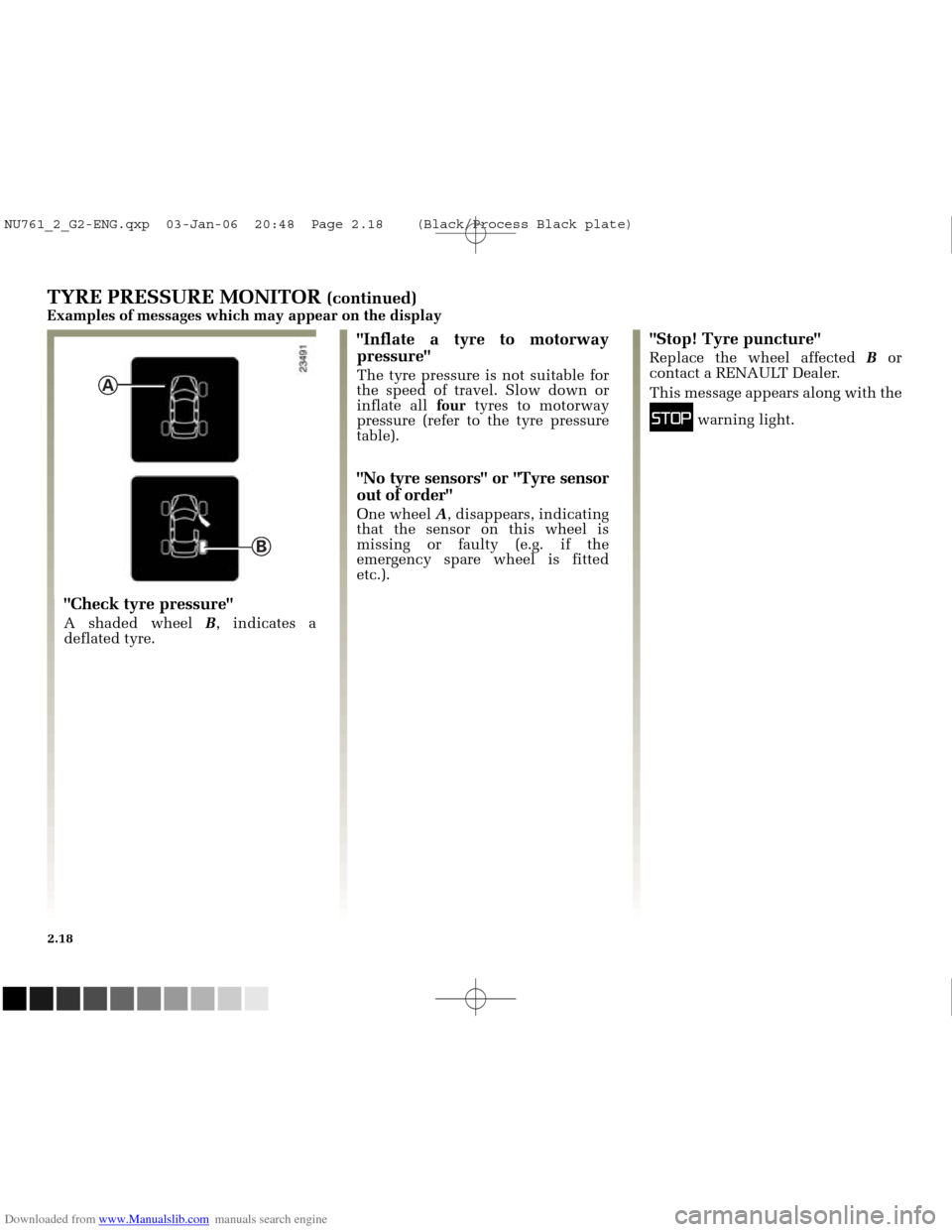
Downloaded from www.Manualslib.com manuals search engine
A
B
NU761_2_G2-FRA.qxd 4/11/05 10:48 Page 2.18
2.18
TYRE PRESSURE MONITOR (continued)Examples of messages which may appear on the display
"Check tyre pressure"
A shaded wheel B, indicates a
deflated tyre.
"Stop! Tyre puncture"
Replace the wheel affected Bor
contact a RENAULT Dealer.
This message appears along with the
ûwarning light.
"Inflate a tyre to motorway
pressure"
The tyre pressure is not suitable for
the speed of travel. Slow down or
inflate all fourtyres to motorway
pressure (refer to the tyre pressure
table).
"No tyre sensors" or "Tyre sensor
out of order"
One wheel A, disappears, indicating
that the sensor on this wheel is
missing or faulty (e.g. if the
emergency spare wheel is fitted
etc.).
NU761_2_G2-ENG.qxp 03-Jan-06 20:48 Page 2.18 (Black/Process Black\
plate)
Page 119 of 250
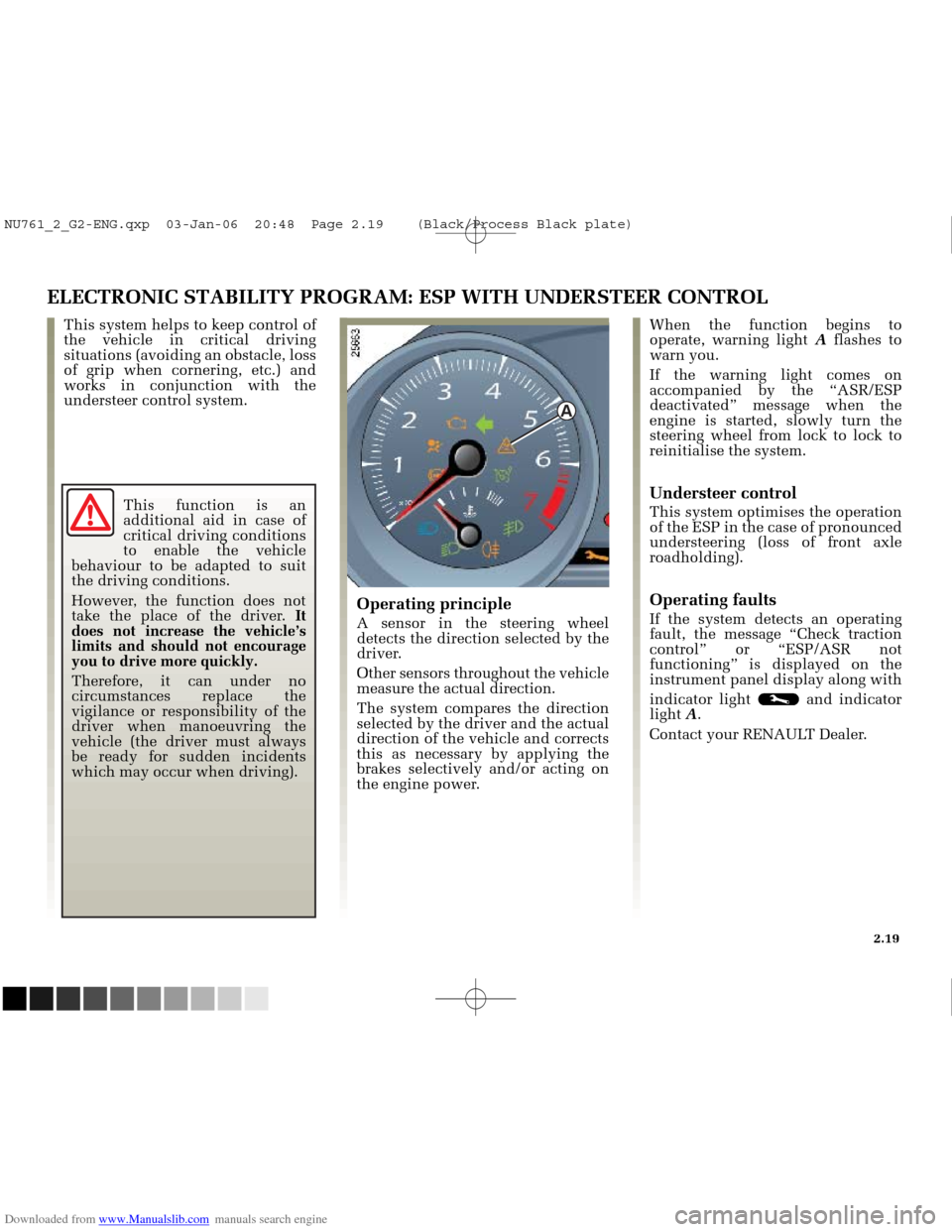
Downloaded from www.Manualslib.com manuals search engine
A
NU761_2_G2-FRA.qxd 4/11/05 10:48 Page 2.19
ELECTRONIC STABILITY PROGRAM: ESP WITH UNDERSTEER CONTROL
When the function begins to
operate, warning light Aflashes to
warn you.
If the warning light comes on
accompanied by the “ASR/ESP
deactivated” message when the
engine is started, slowly turn the
steering wheel from lock to lock to
reinitialise the system.
Understeer control
This system optimises the operation
of the ESP in the case of pronounced
understeering (loss of front axle
roadholding).
Operating faults
If the system detects an operating
fault, the message “Check traction
control” or “ESP/ASR not
functioning” is displayed on the
instrument panel display along with
indicator light and indicator
light A.
Contact your RENAULT Dealer.
This system helps to keep control of
the vehicle in critical driving
situations (avoiding an obstacle, loss
of grip when cornering, etc.) and
works in conjunction with the
understeer control system.
Operating principle
A sensor in the steering wheel
detects the direction selected by the
driver.
Other sensors throughout the vehicle
measure the actual direction.
The system compares the direction
selected by the driver and the actual
direction of the vehicle and corrects
this as necessary by applying the
brakes selectively and/or acting on
the engine power.
2.19
This function is an
additional aid in case of
critical driving conditions
to enable the vehicle
behaviour to be adapted to suit
the driving conditions.
However, the function does not
take the place of the driver. It
does not increase the vehicle’s
limits and should not encourage
you to drive more quickly.
Therefore, it can under no
circumstances replace the
vigilance or responsibility of the
driver when manoeuvring the
vehicle (the driver must always
be ready for sudden incidents
which may occur when driving).
NU761_2_G2-ENG.qxp 03-Jan-06 20:48 Page 2.19 (Black/Process Black\
plate)
Page 120 of 250
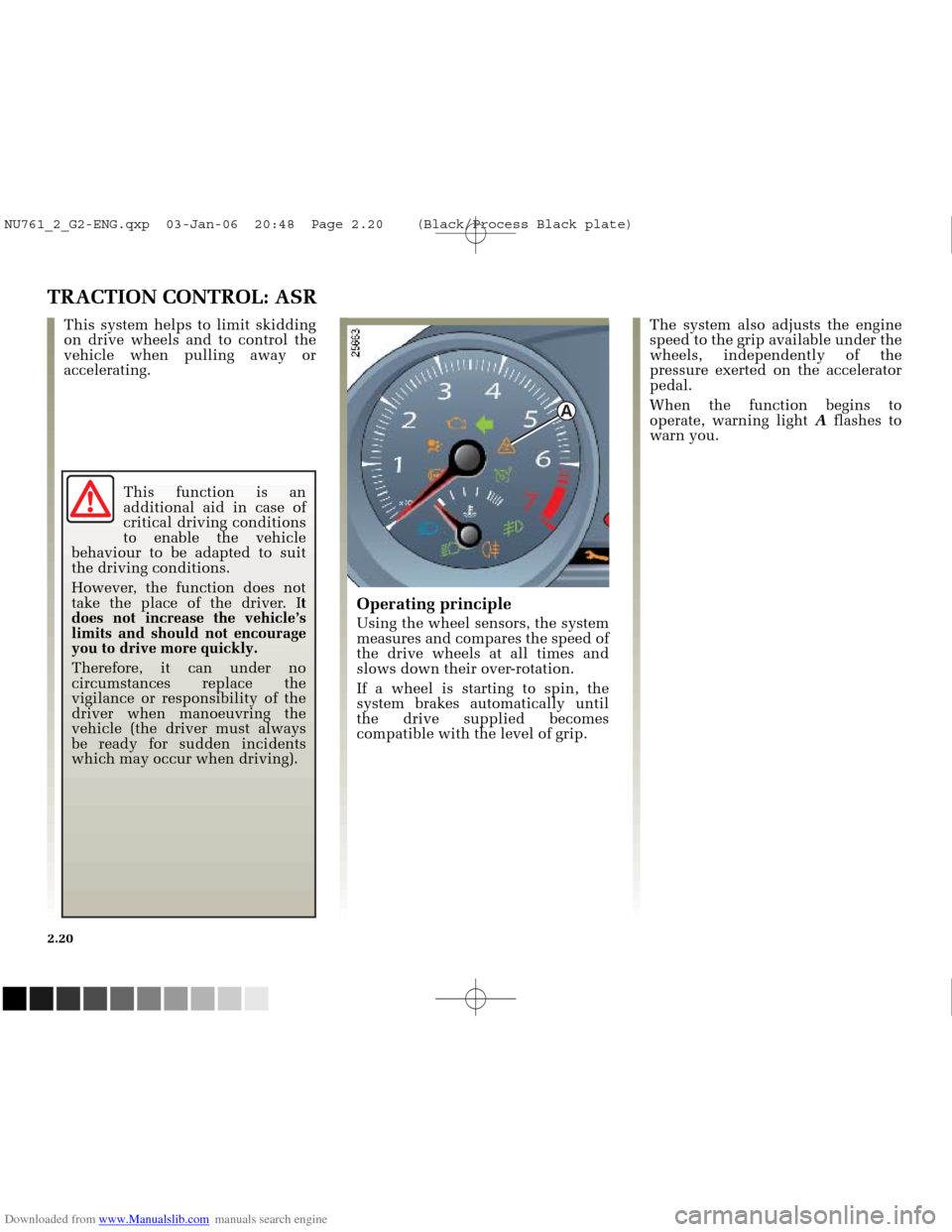
Downloaded from www.Manualslib.com manuals search engine
A
NU761_2_G2-FRA.qxd 4/11/05 10:48 Page 2.20
2.20
TRACTION CONTROL: ASR
Operating principle
Using the wheel sensors, the system
measures and compares the speed of
the drive wheels at all times and
slows down their over-rotation.
If a wheel is starting to spin, the
system brakes automatically until
the drive supplied becomes
compatible with the level of grip.The system also adjusts the engine
speed to the grip available under the
wheels, independently of the
pressure exerted on the accelerator
pedal.
When the function begins to
operate, warning light
Aflashes to
warn you.
This system helps to limit skidding
on drive wheels and to control the
vehicle when pulling away or
accelerating.
This function is an
additional aid in case of
critical driving conditions
to enable the vehicle
behaviour to be adapted to suit
the driving conditions.
However, the function does not
take the place of the driver. I t
does not increase the vehicle’s
limits and should not encourage
you to drive more quickly.
Therefore, it can under no
circumstances replace the
vigilance or responsibility of the
driver when manoeuvring the
vehicle (the driver must always
be ready for sudden incidents
which may occur when driving).
NU761_2_G2-ENG.qxp 03-Jan-06 20:48 Page 2.20 (Black/Process Black\
plate)